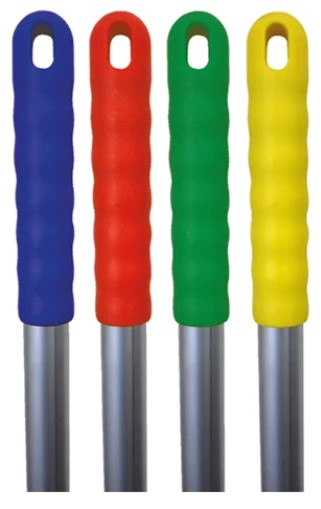Posted by Hygenol Cleaning Supplies on 13th Aug 2024
The Importance of Colour-Coded Cleaning Products in Preventing Cross-Contamination
In the world of professional cleaning and janitorial services, maintaining the highest standards of hygiene is paramount. One of the most effective methods to prevent cross-contamination in any environment is the use of colour-coded cleaning products. From mop buckets and mop handles to cloths, brushes, and mop heads, colour-coding is a simple yet powerful system that ensures cleaning tasks are carried out safely and efficiently. In this blog post, we’ll explore why colour-coded cleaning products are essential and how they can be implemented to protect the health and safety of everyone in your facility.
Why Colour-Coding Matters
Cross-contamination occurs when bacteria and other harmful microorganisms are transferred from one area to another, often through cleaning equipment that has been used improperly. This can lead to serious health risks, especially in environments where hygiene is critical, such as healthcare facilities, food service areas, and public spaces.
Colour-coding provides a straightforward solution to this problem by assigning specific colours to different cleaning zones or tasks. This system reduces the risk of cross-contamination by ensuring that tools used in one area are not inadvertently used in another. The result is a safer, more hygienic environment for everyone.

Understanding the Colour-Coding System
The colour-coding system typically involves four main colours, each representing a specific area or level of risk:
- Yellow: For isolation areas. This colour is designated for areas that require the most stringent cleaning protocols, such as isolation rooms in healthcare facilities. Cleaning tools marked with yellow should never be used outside of these high-risk areas.
- Red: For high-risk areas. Red is used for areas that pose a significant risk of contamination, such as bathrooms and washrooms. These spaces require dedicated cleaning tools to prevent the spread of harmful bacteria and pathogens.
- Green: For food service areas. In environments where food is prepared, served, or stored, green-coded products ensure that surfaces are cleaned with tools that are exclusively used in food-related zones. This helps prevent the contamination of food with cleaning agents or bacteria from other areas.
- Blue: For general areas. Blue is used for low-risk areas such as offices, hallways, and public spaces. While these areas still require regular cleaning, the risk of cross-contamination is lower, making blue-coded tools suitable for these tasks.
Implementing Colour-Coded Cleaning in Your Facility
To effectively implement a colour-coded cleaning system, it’s important to clearly communicate the colour-coding rules to your entire cleaning staff. Here are some steps to get started:
- Label Equipment Clearly: Ensure that all cleaning tools, including mop buckets, mop handles, mop heads, cloths, and brushes, are clearly marked with their designated colour. This can be done through the use of coloured handles, tags, or labels.
- Train Your Team: Provide comprehensive training to your cleaning staff on the importance of colour-coding and how to correctly use colour-coded tools. Regular refresher courses can help maintain awareness and adherence to the system.
- Monitor and Enforce Compliance: Regularly monitor cleaning practices to ensure that the colour-coding system is being followed. Implementing checklists or audits can help maintain compliance and identify areas for improvement.
- Maintain Supplies: Make sure you have a sufficient supply of colour-coded cleaning tools to prevent any mixing of equipment. Stock up on spare items in each colour to ensure that replacements are readily available.
The Benefits of Colour-Coding
By implementing a colour-coded cleaning system, your facility can enjoy several key benefits:
- Reduced Risk of Cross-Contamination: The primary benefit of colour-coding is the significant reduction in the risk of cross-contamination, leading to a safer and more hygienic environment.
- Improved Efficiency: With a clear system in place, cleaning tasks can be performed more efficiently, as staff members know exactly which tools to use for each area.
- Compliance with Health Regulations: Many industries, especially healthcare and food service, require strict adherence to hygiene standards. A colour-coded system helps ensure compliance with these regulations.
- Enhanced Professionalism: A well-organized and consistent cleaning approach reflects positively on your business, demonstrating a commitment to maintaining the highest standards of cleanliness and safety.
Conclusion
In any environment where cleanliness is critical, preventing cross-contamination is a top priority. Implementing a colour-coded cleaning system is a simple yet highly effective way to safeguard the health and safety of your facility’s occupants. By dedicating specific tools to specific areas and training your staff on the importance of this system, you can ensure that your cleaning practices meet the highest standards of hygiene and efficiency.
At Hygenol, we offer a wide range of colour-coded cleaning products, including mop buckets, handles, mop heads, cloths, and brushes, all designed to help you implement this essential system with ease. Browse our selection today and take the first step towards a cleaner, safer environment.

